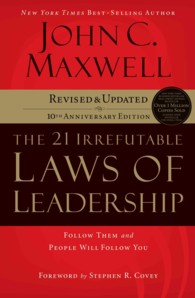The 21 Irrefutable Laws of Leadership: Follow Them and People Will Follow You
John C. Maxwell’s seminal work, The 21 Irrefutable Laws of Leadership, provides a comprehensive framework for understanding and applying the timeless principles of effective leadership. Drawing from decades of experience, Maxwell presents each law with clarity, practical examples, and actionable insights, making it an indispensable guide for aspiring and seasoned leaders alike.
Key Laws and Their Impact
Maxwell organizes his insights into 21 distinct laws, each building upon the others to form a holistic view of leadership. Some of the most impactful laws include:
The Law of the Lid
This foundational law states that leadership ability determines a person’s level of effectiveness. The lower an individual’s ability to lead, the lower the lid on their potential. To increase effectiveness, one must raise their leadership lid.
The Law of Influence
True leadership is not about position, title, or seniority; it’s about influence. Maxwell asserts that if you can’t influence people, they won’t follow you, regardless of your official role. Influence is earned through character, competence, and connection.
The Law of Process
Leadership is not an event but a continuous journey. The Law of Process emphasizes that leadership develops daily, not in a day. It requires consistent effort, learning, and growth over time.
The Law of Navigation
Any person can steer the ship, but it takes a leader to chart the course. The Law of Navigation highlights the leader’s role in planning, strategizing, and guiding their team through challenges to reach their destination.
The Law of Addition
Leaders add value to others by serving them. This law underscores the importance of selfless leadership, where the leader’s primary focus is on empowering and uplifting those they lead.
The Law of Solid Ground
Trust is the foundation of leadership. The Law of Solid Ground asserts that trust is built on competence, connection, and character. Without trust, a leader’s influence crumbles.
The Law of the Inner Circle
A leader’s potential is directly proportional to the strength of their inner circle. This law emphasizes the importance of surrounding oneself with a strong, capable, and supportive team.
The Law of Empowerment
Only secure leaders give power to others. The Law of Empowerment teaches that true leaders empower their followers, fostering growth and initiative, rather than hoarding power out of insecurity.
The Law of the Picture
People do what people see. The Law of the Picture highlights the importance of leading by example. Leaders must model the behavior and values they wish to see in their team.
The Law of Buy-In
People buy into the leader, then the vision. This law explains that followers first commit to the leader’s character and credibility before embracing their vision or mission.
Practical Application and Timeless Wisdom
Maxwell illustrates each law with compelling anecdotes and real-world examples, making the concepts accessible and memorable. The book encourages readers to reflect on their own leadership journey and identify areas for growth. While the context of leadership may evolve, the fundamental principles outlined in these laws remain constant, offering timeless wisdom for anyone seeking to enhance their leadership effectiveness.
Conclusion
The 21 Irrefutable Laws of Leadership is more than just a book; it’s a practical manual for leadership development. By understanding and applying these laws, individuals can cultivate the qualities necessary to influence others, build strong teams, and achieve significant results. It serves as a powerful reminder that leadership is a learnable skill, and consistent application of these principles can transform anyone into a more impactful leader.



